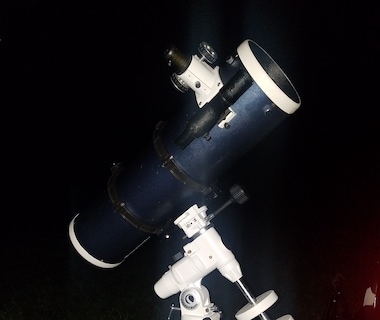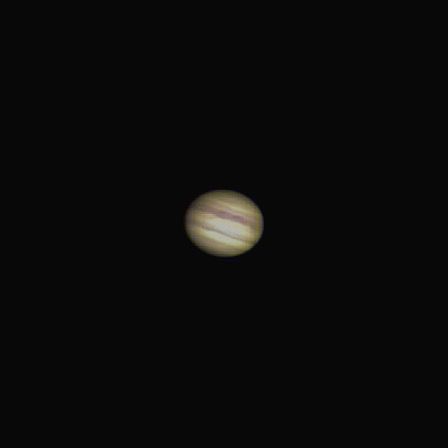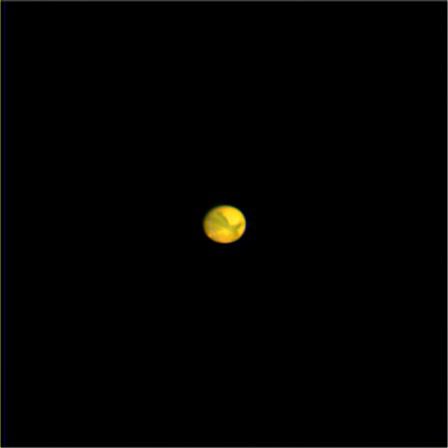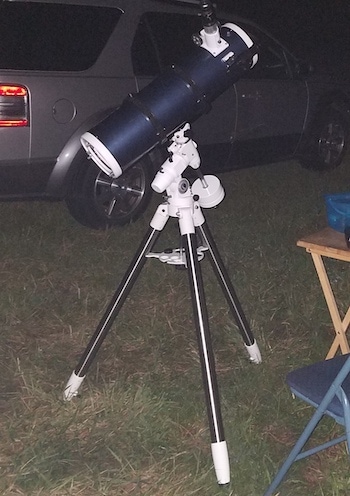The Optical Tube Assembly Reviewed

The optical tube uses a standard imported Synta mirror set with 150mm aperture, 750mm focal length, and a focal ratio f/5. It uses Celestron’s StarBright XLT coatings, which purports 95% reflectivity per mirror, which can be better than the 88% reflectivity of a simple aluminized mirror. Combined with the short focal ratio, the views will be very bright through the eyepiece. The secondary obstruction is somewhat larger than the obstruction in a 6” f/8 Dobsonian, meaning contrast may be very slightly reduced, but the higher reflectivity makes up for it and results in about the same performance on deep sky objects at the same magnification. However, since the 6” f/8 Dob can’t reach its lowest useful power (and thus greatest useful surface brightness) with a wide field eyepiece, the XLT 150 has the upper hand when used in dark skies.
The telescope is capable of working up to 300x magnification, but at f/5, collimation is extremely important and must be touched up every observing session. The minimum power will be around 25x. Maximum field of view is around a whopping 3.7 degrees when used with a very-wide-field 2” eyepiece. When using typical 1.25” eyepieces, the maximum field of view is around 2.4 degrees, which is still plenty enough to fit in practically any large deep sky object you might want to view, such as the bright part of the Andromeda Galaxy and the Pleiades.
In practice, though, I’ve found that I almost never took advantage of the super-low-power / super-wide-angle / super-high-surface-brightness view through this telescope, instead preferring to stay around the same powers that I’d use in my 6” f/8 Dobsonian. This is largely due to light pollution skyglow, which was very noticeable at the low powers. I expect that in a very dark site, the ultra-low-power view of a fast reflector would be more useful.
The optics are comparable to those in the Orion StarBlast 6 and SkyWatcher Heritage 150P, both of which are tabletop Dobsonians.
The blue and white optical tube contains a 2” Crayford Focuser (although the unit I evaluated was an older one, with a 1.25” Rack & Pinion focuser) capable of accepting 2” ultra-wide-field eyepieces and coming into focus with a DSLR or other prime-focus camera, without the use of a Barlow. There is a Synta Finder Shoe for the included finderscope, and the telescope can be collimated with 3 large thumbscrews on the back, with additional locking screws which may not be necessary.
The CG-4 German Equatorial Mount

The CG-4 mount, which is identical to the EQ 3-2 mount sold by other sellers, is a fine piece of work. It is a manually operated equatorial mount, with buttery smooth motions, but it will stay just where you leave it when it is balanced, and the slow motion cables allow for easy manual tracking.
The telescope must be aligned with the celestial pole before it can be used. In the northern hemisphere, this can be accomplished with the aid of a polar alignment scope (sold separately) or by using the telescope in the “home position” and with the use of drift alignment. For a beginner, this operation can be difficult to understand and perform.
The mount has setting circles that have a chance of actually being useful. Most beginner equatorial mount setting circles are designed to make the telescope look cool and scientific, and are unlikely to actually be useful. However, the use of a vernier on the Right Ascension setting circle allows for precision of about 1/10th to 1/5th of a degree, which is definitely enough to place objects within the field of view of the telescope at low power, assuming the telescope has been accurately polar aligned.
The mount’s slow motion controls were a little rough and difficult to turn in the declination axis, but only the right ascension axis–which remained buttery smooth–is necessary for manual tracking. The slow motion cables use large, very comfortable plastic knobs that feel great in the hand. They attach to the mount with a screwdriver rather than using thumbscrews, so keep that in mind if you need to remove them. I found having access to slow motions a welcome change compared to the Dobsonian (though I’m not sure they alone are worth the extra price).
The mount is compatible with a standard Vixen dovetail. A Vixen dovetail and white tube rings are included with the telescope.
The mount comes with two weights of different masses, and they can be placed anywhere along the counterweight shaft to bring the telescope as a whole into balance.
The tripod is very sturdy, and uses an eyepiece tray as a spreader. The tray has 1.25” and 2” holes for eyepieces, and so can only hold eyepieces, not other accessories like dust caps or lights. I use the tripod fully retracted, as it puts the telescope at a comfortable height for most eyepiece positions.
The Ergonomics of an Equatorial Mounted Newtonian
I like the telescope’s parts a lot, individually. Together, though, they are somewhat lacking. At the price and general quality of this instrument, I wish I could say that I enjoyed using it. The truth is that I almost never used it, and when I did, I’d often be more frustrated than not. This is, to be clear, an issue of personal preference. People have been using equatorial newts for a century before me, and I’m sure they’ll be using them a century hence.
The issue is that a Newtonian just isn’t a good fit for visual work on an equatorial mount. The focuser position, where you look into the telescope, ends up at all sorts of odd angles, which can be difficult to actually go and look through, especially if you also want to use the finderscope. The solution is to loosen the tube rings, rotate the telescope (without moving the tube forward or backwards, which would unbalance it), and tighten the tube rings. This isn’t too bad when you’re staying in one part of the sky, but when you move to a different part of the sky, you have to stop what you’re doing and rotate the tube and rebalance the mount. It’s distracting, frustrating, and takes you out of the observing experience.
A hint I found all too late is that if you place the focuser so that it is pointing directly up opposite the counterweight shaft, you get the most usable set of eyepiece orientations. When imaging with a camera, it is helpful to point the focuser the other way, towards the counterweight shaft, which is easiest to balance.
This did not interfere with my usage enough that I could not find objects. I could even star-hop to a new object I hadn’t observed before, and I found the maximum true field attainable with the scope to be very useful in star-hopping, allowing larger asterisms to be used to get you on target.
Between the complex set up, alignment, and re-balancing act that has to go on before you can observe, I found that I often ignored this telescope, and as a primarily visual astronomer, I was mostly happy with my 6” f/8 Dobsonian. As a result, when saving up money to get a larger dob, I sold my XLT 150. But it could easily have gone the other way, for someone who prefers the ability to track or do some photography.
Reviewing Provided Accessories
The Omni XLT 150 is fairly light on accessories. There’s a 6×30 Finderscope, a straight-thru unit which is acceptable, though not as useful as a Right-Angle Correct Image (RACI) finderscope would be. I found it annoying to adjust the two-axis alignment set screws on the finder mount, and the finderscope would often lose alignment if it were bumped or moved to a different part of the sky.
The other accessory is a 25mm Plossl eyepiece, which oddly enough isn’t just a typical 25mm Celestron Omni Plossl, it’s some design that, so far as I can tell, is unique to the Omni XLT telescopes. With a 50-degree field of view and 20mm of eye relief, it ought to be a Plossl. 25mm is a fine focal length for practically any telescope, but at f=750mm, the magnification of 30x leaves something to be desired. I assume this is because the telescope is not meant for beginners, the implication being that you either have the budget to buy new eyepieces, or you have an existing collection.
If you want to reach high power for planetary viewing, only a few good short-focus, well-corrected eyepieces are available, and they’re expensive. Instead, you might want to use a 2x-3x Barlow and a high or medium power eyepiece. F/5 is tough on a lot of simple eyepiece designs like Kellners and Abbe Orthoscopics, so a Barlow can steepen the light cone and make those minimum-glass designs work better.
Celestron sells two main accessories, a polar finderscope and a 2-axis motor drive system. Both are very useful if you want to use the telescope for astrophotography. When the motor drive is attached, the motor hand controller replaces the slow motion cables for manual slewing, and can be used for two-axis tracking. The polar axis scope can get you even closer to a proper alignment with the polaris.
Though celestron does not support this, it is in fact possible to use the EQ-1/EQ-2/CG2/CG3 motor drive (intended for AstroMaster/PowerSeeker telescopes) using the CG2 mounting bracket to drive the Right Ascension axis of the telescope for rudimentary single-axis tracking.
Photography Capabilities
This telescope is not an astrograph, and it is not designed to do astrophotography. However, with the motor drive kit, it is possible to get short and medium-exposure photographs of bright deep sky objects and stackable videos of the planets and Moon.
After I sold my Omni XLT 150, the person I sold it to sent me some pictures of the planets that he took with the telescope. Planetary images by Adam Braxton, amateur astrophotographer, used with permission.



With the two-axis motor drive, sub-exposures in the 30-90 seconds time frame should be attainable, and by stacking multiple such exposures to reduce noise, some rudimentary deep sky and cometary astrophotos could possibly be made. Motorized tracking is a necessity for deep sky photography, but not so much for planetary astrophotos. Though a fast Newtonian is not the best choice for planetary photos, if the telescope is in very good collimation and the planet is sized correctly over the camera sensor (requiring a barlow lens), the results can be very good, and Adam’s photos are admittedly not as good as what this scope is capable of, so there is room for improvement (both for Adam, who is a beginner to this form of astrophotography, and for anyone who wants to try this for themself).
I will point out that an equatorial mount, tracked or otherwise, is merely a convenience for planetary photos, as an altaz/dobsonian can take planetary and lunar astrophotos using the drift method, whereby you keep the telescope stationary and let the planet drift across the frame, repeating this several times until you have enough data.


The Celestron Omni XLT150 faces competition in its price range, especially from Dobsonian telescopes, which offer larger optical tubes for the same or lower cost. The article suggests considering options like the Orion StarBlast 6 or the SkyWatcher Heritage 150P if you prefer a Dobsonian format for a 6″ short-focus optical tube.